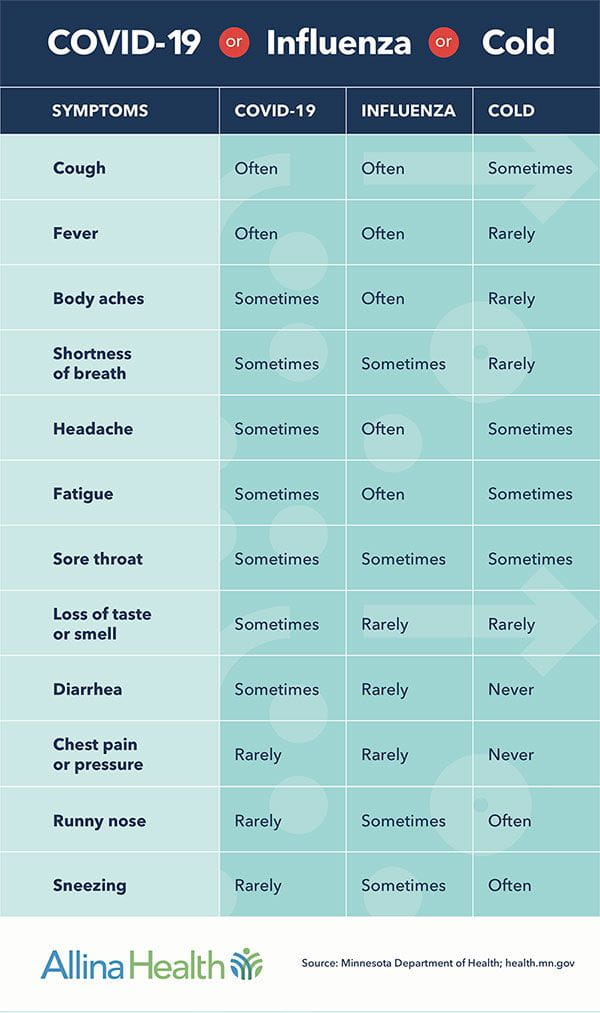With the ongoing COVID-19 pandemic and surging respiratory syncytial virus (RSV) cases, this cold and flu season will be a lot more complicated. If you start feeling an itchy throat or a cough, you may wonder, “Am I catching a cold, the flu or something else?” This article will help you tell the difference—and get the right care.
Symptoms of the flu
The first flu cases usually appear in October and the season peaks from December to March. Here are some common flu symptoms:
- fever
- chills
- cough
- sore throat
- runny or stuffy nose
- muscle or body aches
- headaches
- fatigue (feeling tired)
- in some cases, vomiting and diarrhea
Now, getting a flu shot is more important than ever—the sooner, the better. By reducing the number of flu cases, we can ease the burden on our health care system so that care will be available when you and others need it most. Find an Allina Health flu shot location.

The flu vs. cold
Colds and influenza have some symptoms in common, but they are caused by different viruses and have different symptoms, severity and complications. You can tell the difference in a few important ways:
How quickly it can hit you. A cold comes on gradually, and you’ll notice symptoms increasing over several days. The flu usually comes on quickly, and in just a day or two, you may feel completely wiped out.
How long it lasts. A cold usually winds down in a week to 10 days. The flu can last up to two or three weeks, with a runny nose and cough usually the last symptoms to resolve.
How intense it is. Generally, flu symptoms are more intense, with fever, coughing, and body aches that are more severe than a cold.
What other problems it can cause. The flu is more likely to lead to other health problems, such as a flare-up of underlying lung disease (such as asthma or COPD), dehydration due to vomiting and/or diarrhea, or pneumonia.
The flu vs. COVID-19
COVID-19 and seasonal flu are spread in similar ways and have many similar symptoms, which can make it difficult to tell them apart.
Key similarities. Both illnesses cause fever, chills, cough, muscle or body aches, and sore throat. Both illnesses can cause other health issues like pneumonia. Both can be fatal, particularly in older people or those with underlying health conditions.
Key difference. In addition to flu-like symptoms, COVID-19 often causes a loss of taste or smell.
For more on COVID-19 testing, treatment, prevention and care options, visit the Allina Health COVID-19 Resource Center.
The flu vs. RSV
RSV season usually starts in the fall and peaks in the winter. RSV symptoms tend to start gradually, while the flu develops more suddenly.
How symptoms affect you can depend on your age. Most healthy adults won’t have serious RSV symptoms, but the flu and COVID-19 can be more severe. RSV can be more severe for infants, children with lung conditions, adults ages 65 and older and people with weakened immune systems.
Symptoms of RSV include:
- a cough, which takes a big turn for the worse on day three of the illness
- a runny or stuffy nose
- decreased appetite
- sneezing
- fever
- wheezing
Treatment for the flu, RSV and a cold
Most viral symptoms will go away with home treatment:
- Stay home until your fever, chills, and body aches have resolved—which can take up to five days after those symptoms start—to avoid spreading the virus to others.
- Get plenty of rest.
- Drink lots of liquids to stay hydrated.
- Eat foods that are nourishing and easy to digest.
- Take over-the-counter medications to ease symptoms.
When and where to seek care
If you start feeling even worse after a few days, call your doctor or seek medical care. Anti-viral medication for the flu needs to be started within 48 hours of symptom onset for most people, and anti-viral medication for COVID-19 disease needs to be started within five days of symptom onset.
Explore convenience care options at Allina Health, including virtual visits, walk-in care and more. If you or a loved one has severe symptoms (high fever, difficulty breathing, bluish skin color), call 911 or visit the nearest hospital emergency department.

View the "Do You Have COVID-19, Flu, or a Cold" graphic in an alternative format.








